Chapter 18: Consolidated statement of financial position
Chapter learning objectives
Upon completion of this chapter you will be able to:
- prepare a consolidated statement of financial position for a simple group (parent and one subsidiary)
- deal with pre- and post-acquisition profits
- deal with non-controlling interests (at fair value)
- describe the required accounting treatment of consolidated goodwill
- apply the required accounting treatment of consolidated goodwill
- explain the consolidation of other reserves (e.g. share premium and revaluation)
- account for the consolidation of other reserves
- account for the effects of intra-group trading in the statement of financial position
- explain why it is necessary to use fair values
- Acquisitions of subsidiaries part way through the financial year.
1 Principles of the consolidated statement of financial position
The concept of group accounts
What is a group?
If one company owns more than 50% of the ordinary shares of another company:
- this will usually give the first company 'control' of the second company
- the first company (the parent company, P) has enough voting power to appoint all the directors of the second company (the subsidiary company, S)
- P is, in effect, able to manage S as if it were merely a department of P, rather than a separate entity
- in strict legal terms P and S remain distinct, but in economic substance they can be regarded as a single unit (a 'group').
Definitions
IAS 27 Consolidated and Separate Financial Statements uses the following definitions:
- subsidiary – an entity that is controlled by another entity (known as the parent)
- control – the power to govern the financial and operating policies of an entity so as to obtain benefits from its activities
Requirements for consolidated financial statements
IAS 27 outlines the circumstances in which a group is required to prepare consolidated financial statements.
Consolidated financial statements should be prepared when theparent company has control over the subsidiary. Control is usuallyestablished based on ownership of more than 50% of voting power, butother forms of control are possible.
IAS 27 gives four other situations in which control exists – when the parent has power:
- over more than half the voting rights by virtue of an agreement with other investors
- to govern the financial and operating policies of the entity under a statute or an agreement
- to appoint or remove the majority of the members of the board of directors
- to cast the majority of votes at a meeting of the board of directors.
Exclusion of individual companies from the group accounts
Subsidiary exclusion
An undertaking required to produce group accounts may have (or berequired) to exclude certain subsidiaries on the following basis:
Severe restrictions on control
Subsidiaries to be excluded if the holding company no longer hascontrol. An example of this is a foreign investment where the overseasgovernment has imposed restrictions.
Interest held exclusively for resale
IFRS 5 provides that an investment in a subsidiary which is heldwith an intention to resell in the near future (approximately within oneyear) should not be consolidated.
Method of preparing a consolidated statement of financial position
(1) The investment in the subsidiary(S) shown in the parent’s (P’s) statement of financial position isreplaced by the net assets of S.
(2) The cost of the investment in S is effectively cancelled with the ordinary share capital and reserves of the subsidiary.
This leaves a consolidated statement of financial position showing:
- the net assets of the whole group (P + S)
- the share capital of the group which always equals the share capital of P only and
- the retained profits, comprising profits made by the group (i.e. all of P’s historical profits + profits made by S post-acquisition).

 Illustration 1 – Simple CSFP
Illustration 1 – Simple CSFP
Statements of financial position at 31 December 20X4

P acquired all the shares in S on 31 December 20X4 for a cost of $50,000.
Prepare the consolidated statement of financial position at 31 December 20X4.
Solution
Approach
(1) The balance on ‘investment insubsidiary account’ in P’s accounts will be replaced by theunderlying assets and liabilities which the investment represents, i.e.the assets and liabilities of S.
(2) The cost of the investment in thesubsidiary is effectively cancelled with the ordinary share capital andreserves of S. This is normally achieved in consolidation workings(discussed in more detail below). However, in this simple case, it canbe seen that the relevant figures are equal and opposite ($50,000), andtherefore cancel directly.
This leaves a consolidated statement of financial position showing:
- the net assets of the whole group (P + S)
- the share capital of the group, which equals the share capital of P only – $100,000
- retained earnings comprising profits made by the group. Here this will only include the $30,000 retained earnings of the parent company. S is purchased on the reporting date, therefore there are no post-acquisition earnings to include in the group amount.
By cross-casting the net assets of each company, and cancelling theinvestment in S against the share capital and reserves of S, we arriveat the consolidated statement of financial position given below.
P consolidated statement of financial position at 31 December 20X4
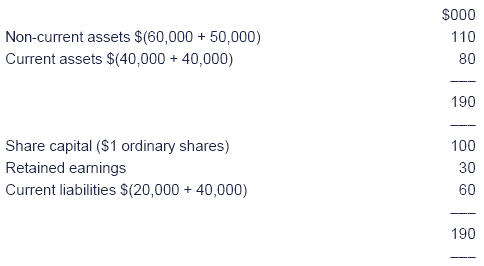
Note: Under no circumstances will any share capital of anysubsidiary company ever be included in the figure of share capital inthe consolidated statement of financial position.

The mechanics of consolidation
 Astandard group accounting question will provide the accounts of P andthe accounts of S and will require the preparation of consolidatedaccounts.
Astandard group accounting question will provide the accounts of P andthe accounts of S and will require the preparation of consolidatedaccounts.
The best approach is to use a set of standard workings.
(W1) Establish the group structure
(W2) Net assets of subsidiary
(W3) Goodwill
(W4) Non controlling interest
(W5) Group retained earnings

 Goodwill
Goodwill
Goodwill on acquisition
In example 1 the cost of the shares in S was $50,000. Equally the net assets of S were $50,000. This is not always the case.
The value of a company will normally exceed the value of its net assets. The difference is goodwill.This goodwill represents assets not shown in the statement of financialposition of the acquired company such as the reputation of thebusiness.
Goodwill on acquisition is calculated by comparing the value of the subsidiary acquired to its net assets.
Where 100% of the subsidiary is acquired, the calculation is therefore:

Where less than 100% of the subsidiary is acquired, the value of the subsidiary comprises two elements:
- The value of the part acquired by the parent
- The value of the part not acquired by the parent, known as the non-controlling interest
There are 2 methods in which Goodwill may be calculated:
(i) Proportion of net assets method (as seen in consolidation workings). Not examinable
(ii) Fair value method (as seen in consolidation workings). Examinable
The proportion of net assets method calculates the portion ofgoodwill attributable to the parent only, while the fair value methodcalculates the goodwill attributable to the group as a whole. This isknown as the gross goodwill i.e. goodwill is shown in full as this isthe asset that the group controls.


 Illustration 2 – Goodwill
Illustration 2 – Goodwill
Daniel acquired 80% of the ordinary share capital of Craig on 31December 20X6 for $78,000. At this date the net assets of Craig were$85,000. NCI is valued using the fair value method and the fair value ofthe NCI on the acquisition date is $19,000
What goodwill arises on the acquisition?
Solution



 IFRS 3 Business Combinations
IFRS 3 Business Combinations
IFRS 3 revised governs accounting for all business combinationsother than joint ventures and a number of other unusual arrangements notincluded in this syllabus. The definition of goodwill is:
Goodwill is an asset representing the future economicbenefits arising from other assets acquired in a business combinationthat are not individually identified and separately recognised.
Goodwill is calculated as the excess of the considerationtransferred and amount of any non-controlling interest over the net ofthe acquisition date identifiable assets acquired and liabilitiesassumed.
Treatment of goodwill
Positive goodwill
- Capitalised as an intangible non-current asset.
- Tested annually for possible impairments.
- Amortisation of goodwill is not permitted by the standard.
Impairment of positive goodwill
If goodwill is considered to have been impaired during thepost-acquisition period it must be reflected in the group financialstatements. Accounting for the impairment differs according to thepolicy followed to value the non-controlling interests.
Proportion of net assets method:
Dr Group reserves (W5)
Cr Goodwill (W3)
Fair value method:
Dr Group reserves (% of impairment attributable to the parent – W5)
Dr NCI (% of impairment attributable to NCI – W4)
Cr Goodwill (W3)
Negative goodwill
- Arises where the cost of the investment is less than the value of net assets purchased.
- IFRS 3 does not refer to this as negative goodwill (instead it is referred to as a bargain purchase), however this is the commonly used term.
- Most likely reason for this to arise is a misstatement of the fair values of assets and liabilities and accordingly the standard requires that the calculation is reviewed.
- After such a review, any negative goodwill remaining is credited directly to the income statement.


 Pre- and post-acquisition reserves
Pre- and post-acquisition reserves
Pre and post-acquisition profits
Pre-acquisition profits are the reserves which exist in a subsidiary company at the date when it is acquired.
They are capitalised at the date of acquisition by including them in the goodwill calculation.
Post-acquisition profits are profits made and included in the retained earnings of the subsidiary company following acquisition.
They are included in group retained earnings.
Group reserves
When looking at the reserves of S at the year end, e.g. revaluation reserve, a distinction must be made between:
- those reserves of S which existed at the date of acquisition by P (pre-acquisition reserves) and
- the increase in the reserves of S which arose after acquisition by P (post-acquisition reserves).
As with retained earnings, only the group share of post-acquisitionreserves of S is included in the group statement of financial position.


 Illustration 3 – Pre- and post-acquisition reserves
Illustration 3 – Pre- and post-acquisition reserves
The following statements of financial position were extracted from the books of two companies at 31 December 20X9.

Derek acquired all of the share capital of Clive one year ago. Theretained earnings of Clive stood at $2,000 on the day of acquisition.Goodwill is calculated using the fair value method. There has been noimpairment of goodwill since acquisition.
Required:
Prepare the consolidated statement of financial position of Derek as at 31 December 20X9.
Solution
Derek consolidated statement of financial position at 31 December 20X9
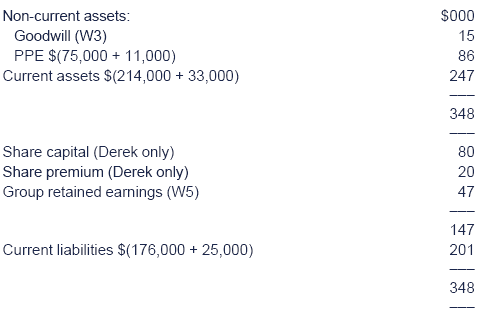
(W1) Establish the group structure
(W2) Net assets of Clive
(W3) Goodwill
(W4) NCI
Not applicable to this example as Clive is 100% owned.
(W5) Group retained earnings


 Non-controlling interests
Non-controlling interests
What is a non-controlling interest?
In some situations a parent may not own all of the shares in thesubsidiary, e.g. if P owns only 80% of the ordinary shares of S, thereis a non-controlling interest of 20%.
Note, however, that P still controls S.
Accounting treatment of a non-controlling interest
As P controls S:
- in the consolidated statement of financial position, include all of the net assets of S (to show control).
- ‘give back’ the net assets of S which belong to the non-controlling interest within the equity section of the consolidated statement of financial position (calculated in W4).


 Test your understanding 1
Test your understanding 1
The following SFPs have been prepared at 31 December 20X8.

D acquired its 80% holding in J on 1 January 20X8, when Js’retained earnings stood at $20,000. On this date, the fair value of the20% non-controlling shareholding in J was $12,500.
The D Group uses the fair value method to value the non-controlling interest.
Prepare the consolidated statement of financial position of D as at 31 December 20X8.

2 Fair values
Fair value of consideration and net assets
To ensure that an accurate figure is calculated for goodwill:
- the consideration paid for a subsidiary must be accounted for at fair value
- the subsidiary’s identifiable assets and liabilities acquired must be accounted for at their fair values.
 The fair valueof assets and liabilities is defined in IFRS 3 (and several otherIFRSs) as ‘the amount for which an asset could be exchanged or aliability settled between knowledgeable, willing parties in an arm’slength transaction’.
The fair valueof assets and liabilities is defined in IFRS 3 (and several otherIFRSs) as ‘the amount for which an asset could be exchanged or aliability settled between knowledgeable, willing parties in an arm’slength transaction’.

 Fair values
Fair values
In order to account for an acquisition, the acquiring companymust measure the cost of what it is accounting for, which will normallyrepresent:
- the cost of the investment in its own statement of financial position
- the amount to be allocated between the identifiable net assets of the subsidiary, the non-controlling interest and goodwill in the consolidated financial statements.
The subsidiary’s identifiable assets and liabilities are includedin the consolidated accounts at their fair values for the followingreasons.
- Consolidated accounts are prepared from the perspective of the group, rather than from the perspectives of the individual companies. The book values of the subsidiary’s assets and liabilities are largely irrelevant, because the consolidated accounts must reflect their cost to the group (i.e. to the parent), not their original cost to the subsidiary. The cost to the group is their fair value at the date of acquisition.
- Purchased goodwill is the difference between the value of an acquired entity and the aggregate of the fair values of that entity’s identifiable assets and liabilities. If fair values are not used, the value of goodwill will be meaningless.
Identifiable assets and liabilities recognised in the accounts arethose of the acquired entity that existed at the date of acquisition.
Assets and liabilities are measured at fair values reflecting conditions at the date of acquisition.
The following do not affect fair values at the date of acquisition and are therefore dealt with as post-acquisition items.
- Changes resulting from the acquirer’s intentions or future actions.
- Changes resulting from post-acquisition events.
- Provisions for future operating losses or reorganisation costs incurred as a result of the acquisition.

Fair value of net assets acquired
IFRS 3 revised requires that the subsidiary’s assets andliabilities are recorded at their fair value for the purposes of thecalculation of goodwill and production of consolidated accounts.
Adjustments will therefore be required where the subsidiary’s accounts themselves do not reflect fair value.
How to include fair values in consolidation workings
(1) Adjust both columns of W2 to bring the net assets to fair value at acquisition and reporting date.
This will ensure that the fair value of net assets is carried through to the goodwill and non-controlling interest calculations.

(2) At the reporting date make the adjustment on the face of the SFP when adding across assets and liabilities.

 Test your understanding 2
Test your understanding 2
Hazelnut acquired 80% of the share capital of Peppermint twoyears ago, when the reserves of Peppermint stood at $125,000. Hazelnutpaid initial cash consideration of $1 million.
Below are the statements of financial position of Hazelnut and Peppermint as at 31 December 20X4:
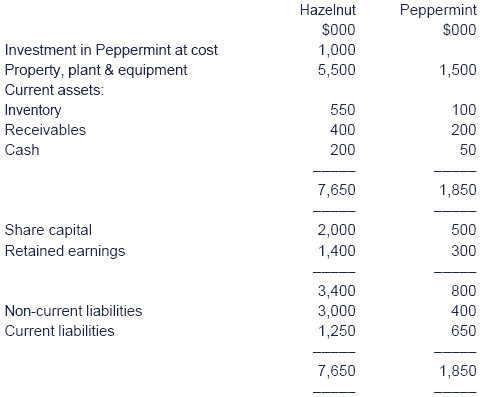
At acquisition the fair values of Peppermint’s plant exceeded itsbook value by $200,000. The fair value of the 20% non-controllinginterest was $380,000
Prepare the consolidated statement of financial position as at 31 December 20X4.

3 Intra-group trading
Types of intra-group trading
P and S may well trade with each other leading to the following potential problem areas:
- current accounts between P and S
- loans held by one company in the other
- dividends and loan interest.
- unrealised profits on sales of inventory
- unrealised profits on sales of non-current assets (not examinable)
Current accounts
If P and S trade with each other then this will probably be done on credit leading to:
- a receivables (current) account in one company’s SFP
- a payables (current) account in the other company’s SFP.
These are amounts owing within the group rather than outside thegroup and therefore they must not appear in the consolidated statementof financial position.
They are therefore cancelled (contra’d) against each other on consolidation.
Cash/goods in transit
At the year end, current accounts may not agree, owing to the existence of in-transit items such as goods or cash.
The usual rules are as follows:
- Once in agreement, the current accounts may be contra’d and cancelled as part of the process of cross casting the assets and liabilities.
- This means that reconciled current account balance amounts are removed from both receivables and payables in the consolidated statement of financial position.

 Test your understanding 3
Test your understanding 3
Fair value adjustments/intercompany balance
Statements of Financial Position of P and S as at 30 June 20X8 are given below:
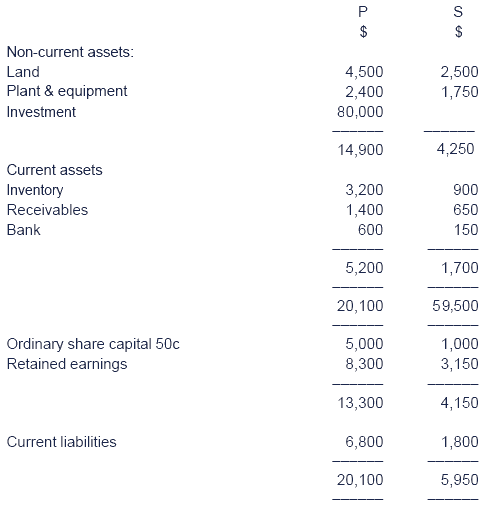
P acquired 75% of S on 1 July 20X5 when the balance on S’sretained earnings was $1,150. P paid $3,500 for its investment in theshare capital of S.
At the reporting date P recorded a payable to S of $400. This agreed to the corresponding amount in S's financial statements.
At the date of acquisition it was determined that S’s land,carried at cost of $2,500 had a fair value of $3,750. S’s plant wasdetermined to have a fair value of $500 in excess of its carrying value.These values had not been recorded by S.
The P group uses the fair value method to value the non-controlling interest which was $1,100.
Required:
Prepare the consolidated statement of financial position of the P group as at 30 June 20X8.

4 Unrealised profit
Profits made by members of a group on transactions with other group members are:
- recognised in the accounts of the individual companies concerned, but
- in terms of the group as a whole, such profits are unrealised and must be eliminated from the consolidated accounts.
Unrealised profit may arise within a group scenario on:
- inventory where companies trade with each other
- non-current assets where one group company has transferred an asset to another. (not examinable)
Intra-group trading and unrealised profit in inventory
When one group company sells goods to another a number of adjustments may be needed.
- Current accounts must be cancelled (see earlier in this chapter).
- Where goods are still held by a group company, any unrealised profit must be cancelled.
- Inventory must be included at original cost to the group (i.e. cost to the company which then sold it).

 PURP
PURP
Where goods have been sold by one group company to another at aprofit and some of these goods are still in the purchaser’s inventoryat the year end, then the profit loading on these goods is unrealised from the viewpoint of the group as a whole.
This is because we are treating the group as if it is a singleentity. No one can make a profit by trading with himself. Until thegoods are sold to an outside party there is no realised profit from the group perspective.
For example, if Pineapple purchased goods for $400 and then soldthese goods onto Satsuma during the year for $500, Pineapple wouldrecord a profit of $100 in their own individual financial statements.The statement of financial position of Satsuma will include closinginventory at the cost to Satsuma i.e. $500.
This situation results in two problems within the group:
(1) The profit made by Pineapple is unrealised. The profit will only become realised when sold on to a third party customer.
(2) The value in Satsuma’s inventory($500) is not the cost of the inventory to the group (cost to the groupwas the purchase price of the goods from the external third partysupplier i.e. $400).
An adjustment will need to be made so that the single entityconcept can be upheld i.e. The group should report external profits,external assets and external liabilities only.

Adjustments for unrealised profit in inventory
The process to adjust is:
(1) Determine the value of closinginventory included in an individual company’s accounts which has beenpurchased from another company in the group.
(2) Use mark-up or margin to calculate how much of that value represents profit earned by the selling company.
(3) Make the adjustments. These will depend on who the seller is.
If the seller is the parent company, the profit element is included in the holding company’s accounts and relates entirely to the group.
Adjustment required:
Dr Group retained earnings (deduct the profit in W5)
Cr Group inventory
If the seller is the subsidiary, the profit element isincluded in the subsidiary company’s accounts and relates partly tothe group, partly to non-controlling interests (if any).
Adjustment required:
Dr Subsidiary retained earnings (deduct the profit in W2 – at reporting date)
Cr Group inventory

 Test your understanding 4
Test your understanding 4
H bought 90% of the equity share capital of S, two years ago on 1January 20X2 when the retained earnings of S stood at $5,000.Statements of financial position at the year end of 31 December 20X3 areas follows:
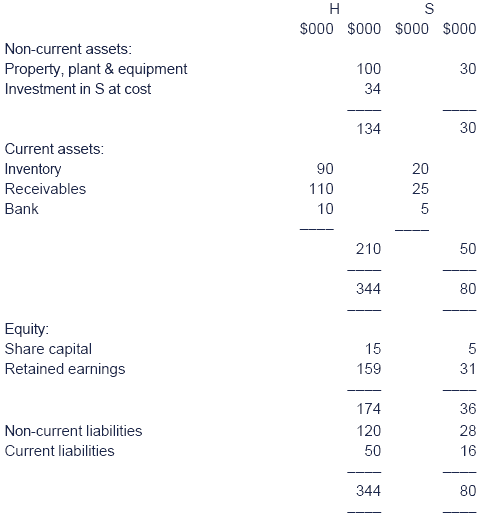
S transferred goods to H at a transfer price of $18,000 at amark-up of 50%. Two-thirds remained in inventory at the year end. Thecurrent account in H and S stood at $22,000 on that day.
The H group uses the fair value method to value the non-controllinginterest. The fair value of the non-controlling interest at acquisitionwas $4,000
Prepare the consolidated statement of financial position at 31/12/X3.

5 Mid-year acquisitions
Calculation of reserves at date of acquisition
If a parent company acquires a subsidiary mid-year, the netassets at the date of acquisition must be calculated based on the netassets at the start of the subsidiary's financial year plus the profitsof up to the date of acquisition.
To calculate this it is normally assumed that S’s profit after tax accrues evenly over time.

 Test your understanding 5
Test your understanding 5
Consolidated Statement of Financial Position
On 1 May 2007 K bought 60% of S paying $76,000 cash. The summarisedStatements of Financial Position for the two companies as at 30November 2007 are:

The following information is relevant:
(1) The inventory of S includes $8,000 of goods purchased from Kat cost plus 25%.
(2) The K Group values thenon-controlling interest using the fair value method. At the date ofacquisition the fair value of the 40% non-controlling interest was$50,000.
(3) S earned a profit of $9,000 in the year ended 30 November 2007.
Required:
Prepare the consolidated Statement of Financial Position as at 30 November 2007.

Chapter summary
Test your understanding answers

 Test your understanding 1
Test your understanding 1
D consolidated statement of financial position as at 31 December 20X8
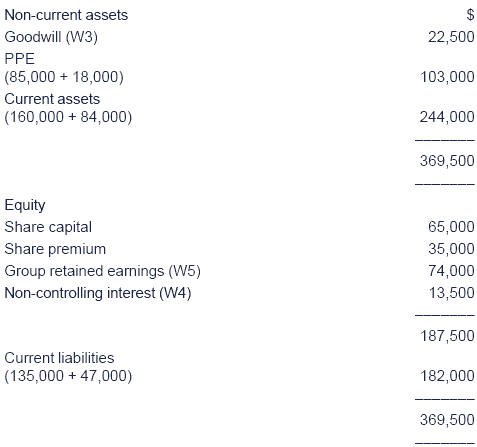
(W1) Group structure
(W2) Net assets of J
(W3) Goodwill
(W4) Non-controlling interests
(W5) Group retained earnings


 Test your understanding 2
Test your understanding 2
Hazelnut consolidated statement of financial position at 31 December 20X4
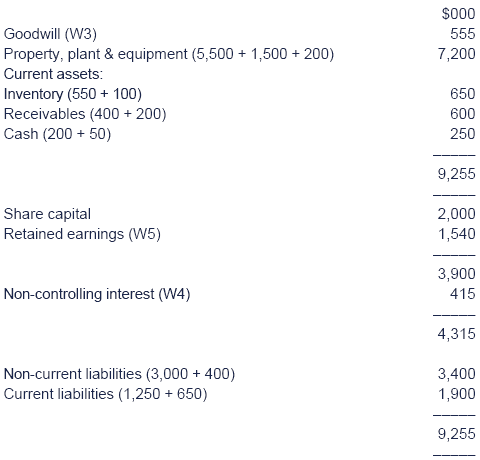
Workings
(W1) Group structure
(W2) Net assets of Peppermint
(W3) Goodwill
(W4) Non-controlling interest
(W5) Group retained earnings


 Test your understanding 3
Test your understanding 3
Consolidated statement of financial position as at 30 June 20X8
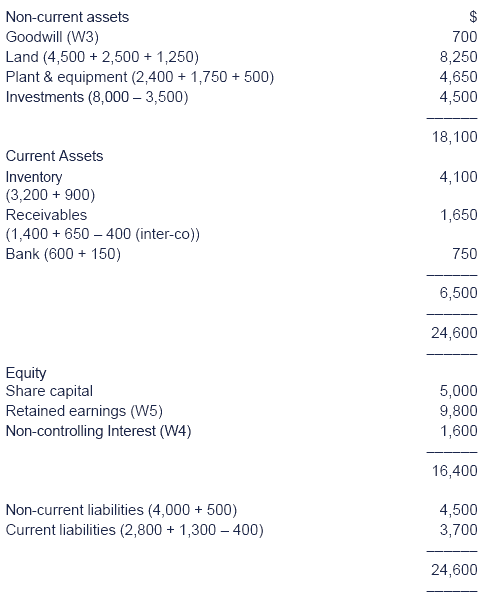
Workings
(W1) Group structure
(W2) Net assets
(W3) Goodwill
(W4) Non-controlling interest
(W5) Group retained earnings


 Test your understanding 4
Test your understanding 4
Solution
Consolidated SFP for H as at 31/12/X3
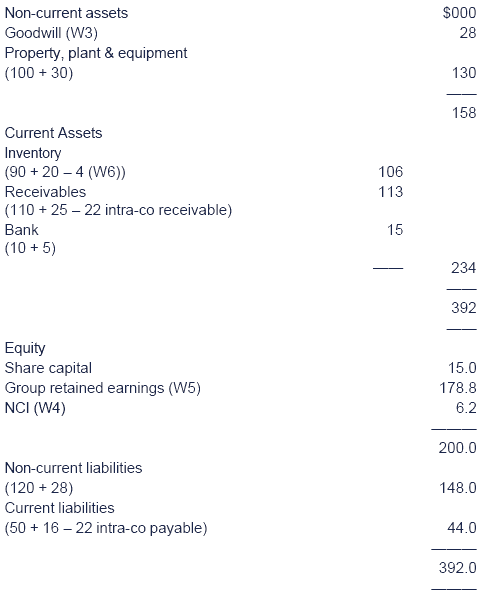
Workings
(W1) Group structure
(W2) Net assets
(W3) Goodwill
(W4) Non-controlling interest
(W5) Group reserves
(W6) PURP


 Test your understanding 5
Test your understanding 5
Consolidated Statement of Financial Position as at 30 November 2007
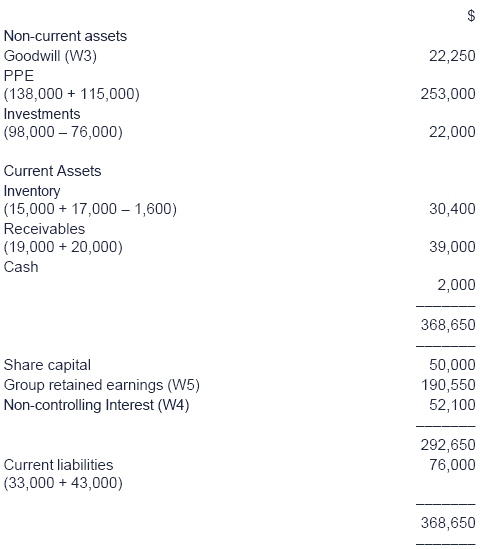
Workings
(W1) Group structure
(W2) Net assets
(W3) Goodwill
(W4) Non-controlling interest
(W5) Group retained earnings
(W6) PURP – Inventory

|
Created at 5/24/2012 3:40 PM by System Account
(GMT) Greenwich Mean Time : Dublin, Edinburgh, Lisbon, London
|
Last modified at 5/25/2012 12:53 PM by System Account
(GMT) Greenwich Mean Time : Dublin, Edinburgh, Lisbon, London
|
|
|
|
 |
Rating
:
|
 Ratings & Comments
(Click the stars to rate the page) Ratings & Comments
(Click the stars to rate the page)
|
 |
Tags:
|
|
|
|
|